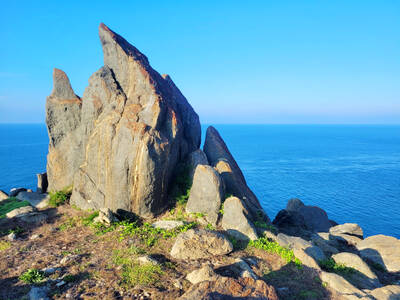It takes a bold man to title his own tour "Incomparable," but, as the king of Mando-pop, Jay Chou (
Starting with his entrance onto the stage at Taipei Municipal Stadium on Saturday night, by being lowered from the rafters on a glowing bright red crucifix, the show was an extravagant statement of Jay's status within the pantheon of Taiwanese pop music.
And the crowd of at least 20,000 who turned up under threatening skies indulged him every step of the way by singing along through all but the newest songs. They even shrugged off Jay's occasional stumbling over his own lyrics.
"I can never remember my lyrics. Thanks for filling in the gaps there," he joked after the crowd eased him through Tornado (
There were also a few awkward audio adjustments at the beginning to make Jay audible over the two drum sets, a bank of extremely enthusiastic back-up singers, a couple of keyboards and three guitars that threatened to smother his voice.
Yet by the fourth song, when he blasted into Yeh Hui-mei (
Jay was on his own, though, through most of his fast rap songs and defied his critics by nailing his lines while keeping step with his dancers through a jamming Aborigine-flavored medley, Father I'm Back (
In the middle of another dance routine moments later, he answered a call on his cellphone, saying: "Hey, I can't talk right now, I'm giving a concert," and then hung up right on cue as the beat came back in. It was all perfectly executed and the kids went wild.
He slowed things down a bit with a short set of acoustic songs, including Clear Stars (星晴) from his eponymous first album, and Love me, don't leave me (愛我別走) by Chang Chen-yue (張震嶽), a perennial KTV favorite that reverberated off the stadium's grandstands.
A two-song interlude by Jay's Alfa Music label-mates Nanquan Ma-ma (
Landy (
But the night belonged to Jay and if the crucifix routine hadn't made that point, then he drove it home with a ripping medley of Luanwu Chun Qiu (
Having hit that high, he made his first exit with Simple Love (
Having gotten what they came for, namely pyrotechnics and a handful of hits, fans started to stream out of the stadium. But Jay returned again to the stage for an anti-climactic rendition of his two contributions to the Hidden Track soundtrack.
After an evening of fireworks, flame-throwers and a solid performance by a singer who's forte is not live concerts, the finale was lackluster by comparison, but as always, the kids screamed in approval. After all, Jay can do no wrong.

One of the most important gripes that Taiwanese have about the Democratic Progressive Party (DPP) is that it has failed to deliver concretely on higher wages, housing prices and other bread-and-butter issues. The parallel complaint is that the DPP cares only about glamor issues, such as removing markers of Chinese Nationalist Party (KMT) colonialism by renaming them, or what the KMT codes as “de-Sinification.” Once again, as a critical election looms, the DPP is presenting evidence for that charge. The KMT was quick to jump on the recent proposal of the Ministry of the Interior (MOI) to rename roads that symbolize

On the evening of June 1, Control Yuan Secretary-General Lee Chun-yi (李俊俋) apologized and resigned in disgrace. His crime was instructing his driver to use a Control Yuan vehicle to transport his dog to a pet grooming salon. The Control Yuan is the government branch that investigates, audits and impeaches government officials for, among other things, misuse of government funds, so his misuse of a government vehicle was highly inappropriate. If this story were told to anyone living in the golden era of swaggering gangsters, flashy nouveau riche businessmen, and corrupt “black gold” politics of the 1980s and 1990s, they would have laughed.

It was just before 6am on a sunny November morning and I could hardly contain my excitement as I arrived at the wharf where I would catch the boat to one of Penghu’s most difficult-to-access islands, a trip that had been on my list for nearly a decade. Little did I know, my dream would soon be crushed. Unsure about which boat was heading to Huayu (花嶼), I found someone who appeared to be a local and asked if this was the right place to wait. “Oh, the boat to Huayu’s been canceled today,” she told me. I couldn’t believe my ears. Surely,

When Lisa, 20, laces into her ultra-high heels for her shift at a strip club in Ukraine’s Kharkiv, she knows that aside from dancing, she will have to comfort traumatized soldiers. Since Russia’s 2022 invasion, exhausted troops are the main clientele of the Flash Dancers club in the center of the northeastern city, just 20 kilometers from Russian forces. For some customers, it provides an “escape” from the war, said Valerya Zavatska — a 25-year-old law graduate who runs the club with her mother, an ex-dancer. But many are not there just for the show. They “want to talk about what hurts,” she